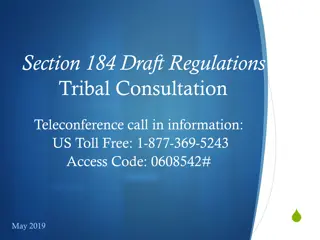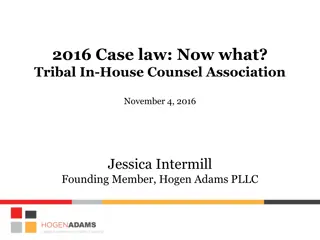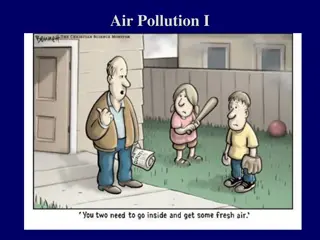Regional Air Quality and Visibility for Tribal Professionals
Understanding regional air quality, visibility, and the impacts of regional haze is crucial for tribal professionals. Clean air is essential for health and cultural practices, while polluted air can diminish visibility and lead to various health and environmental issues. The Clean Air Act aims to control air pollution and improve visibility, addressing regional haze caused by pollutants that affect both nature and human health.
Download Presentation

Please find below an Image/Link to download the presentation.
The content on the website is provided AS IS for your information and personal use only. It may not be sold, licensed, or shared on other websites without obtaining consent from the author.If you encounter any issues during the download, it is possible that the publisher has removed the file from their server.
You are allowed to download the files provided on this website for personal or commercial use, subject to the condition that they are used lawfully. All files are the property of their respective owners.
The content on the website is provided AS IS for your information and personal use only. It may not be sold, licensed, or shared on other websites without obtaining consent from the author.
E N D
Presentation Transcript
Regional Air Quality Regional Air Quality and and the Regional Haze Rule the Regional Haze Rule information and resources for Tribal professionals
Air quality and visibility basics Clean, clear air is important to people from all cultures, worldwide It is an important component of the sacred places in many cultural traditions We appreciate the health benefits of breathing clean air We also enjoy sweeping views in places with clear air, where we can see for miles Polluted air is not only unhealthy to breathe, but can decrease visibility, making it difficult to engage in traditional cultural practices and diminish those sweeping views
Visibility in the Clean Air Act Clean Air Act Main federal legislation to control air pollution Controls a wide range of air pollutants from stationary and mobile sources Primary focus on human and environmental health Visibility also important National Visibility Goal: the prevention of any future, and the remedying of any existing, impairment of visibility in mandatory class I Federal areas which impairment results from manmade air pollution 1 1 Section 169A of the Clean Air Act, 1977 amendments
Regional haze Certain types of air pollution form haze, which interacts with light and diminishes the quality of views across distance Pollution that causes it often comes from far away: thus it is a regional problem Can interfere with cultural practices for Tribal members, and impair enjoyment of special places, such as National Parks and Wilderness Areas
Additional concerns with regional haze Also a symptom of overall air quality problems Same pollutants that cause haze can cause environmental and human health problems: acidification of lakes and streams depletion of soil nutrients damage to culturally important plants, as well as sensitive forests and farm crops aggravated asthma respiratory problems such as irritation of the airways, coughing, or difficulty breathing heart attacks premature death in people with heart or lung disease
Environmental and health problems associated with haze
Pollutants that cause haze Natural sources like wind-blown dust, wildfire smoke Human-caused emissions including: diesel soot fly ash & sulfur dioxides from coal burning nitrogen oxides from power plants and automobiles ammonia from farms and feedlots
Pollutants that cause haze Secondary pollutants formed from reactions between primary pollutants and natural atmospheric components including: sulfates nitrates ozone
Regulation of regional haze Clean Air Act amendments of 1977 set National Visibility Goal Focus on federal Class I areas (larger National Parks, Wilderness Areas, and Wildlife Refuges) 156 federal Class I areas across the country, mostly in the West Tribes can petition the EPA to designate their lands as Tribal Class I areas as well, and there are currently 5 designated Tribal Class I areas in the country These areas have some Clean Air Act protections, but visibility provisions only apply to federal Class I areas
Regional Haze Rule 1990 amendments to Clean Air Act required study of how to improve visibility in Grand Canyon National Park and other Class I areas Regional Haze Rule issued in 1999 to implement study recommendations States must submit State Implementation Plans (SIPs) to control emissions contributing to regional haze Tribes can also submit Tribal Implementation Plans (TIPs) to meet their specific needs, but these are optional
Regional Haze Rule SIPs first submitted by 2010 for a planning period ending in 2018 To be revised and resubmitted in 2021 for the next planning period Include reasonable progress goals (RPGs) for each Class I area in state (measured in deciviews): one for most impaired days (to show improvement) one for least impaired days (to show no degradation)
IMPROVE monitoring network Interagency Monitoring of Protected Visual Environments (IMPROVE) Monitor changes in haze pollutants over time 110 sites in federal Class I areas 48 additional monitoring sites in other areas follow IMPROVE protocol (including 8 on western Tribal lands)
IMPROVE visibility photos Repeat photographs taken from same locations at IMPROVE sites to document short- and long-term variation in visibility Badlands National Park on a: heavily impaired day minimally impaired day
For the western states & Tribes: Western Regional Air Partnership (WRAP) Grew out of the committee assigned to study visibility in Grand Canyon National Park Voluntary partnership of states, Tribes, local air agencies, federal land managers, and the EPA Work together to: address Regional Haze Rule planning & implementation understand current and evolving regional air quality issues in addition to regional haze provide input to EPA in modifications to existing regulations or development of new ones
WRAP member support Development and maintenance of regional databases for air quality emissions and monitoring data Technical analyses and modeling for preparation of SIPs & TIPs Training for member staff in compliance with Regional Haze Rule and other air quality regulations Advocacy for member concerns in federal air quality regulatory actions
Results so far since implementation of the Regional Haze Rule Emissions controls from first planning period reduced emissions of 500,000 tons/year of SO2, and 300,000 tons/year of NOx Eastern Class I areas have seen significant haze reductions on worst days Improvements in western Class I areas not as dramatic
Complications for western states & Tribal lands
Current state of the Regional Haze Rule EPA issued amendments to Rule in 2017 to address second planning period (2018 2028), including: extension of SIP submittal deadline to 2021 strengthening consultation requirements to ensure issues raised early in planning process several adjustments to progress report requirements simplification of the Reasonably Attributable Visibility Impairment (RAVI) provisions of the Rule EPA currently reviewing 2017 amendments, and intends to release revised planning guidance and analysis results in 2019 States working on modeling & analysis for 2021 SIPs
Benefits for Tribes of participation in the process WRAP membership open to any Tribes in the region who wish to participate Stay informed of latest air quality regulations Give input into regulations as they re developed, to have a say in regulations that will affect Tribal lands Increase awareness among states of Tribes as governmental & regulatory agencies Access to technical resources such as air quality models, databases, special studies, and training opportunities Familiarity with partnering state SIP planners and SIP components Opportunities for Tribal staff to form professional networks with federal, industry and environmental colleagues
For more information on WRAP membership: www.wrapair2.org























